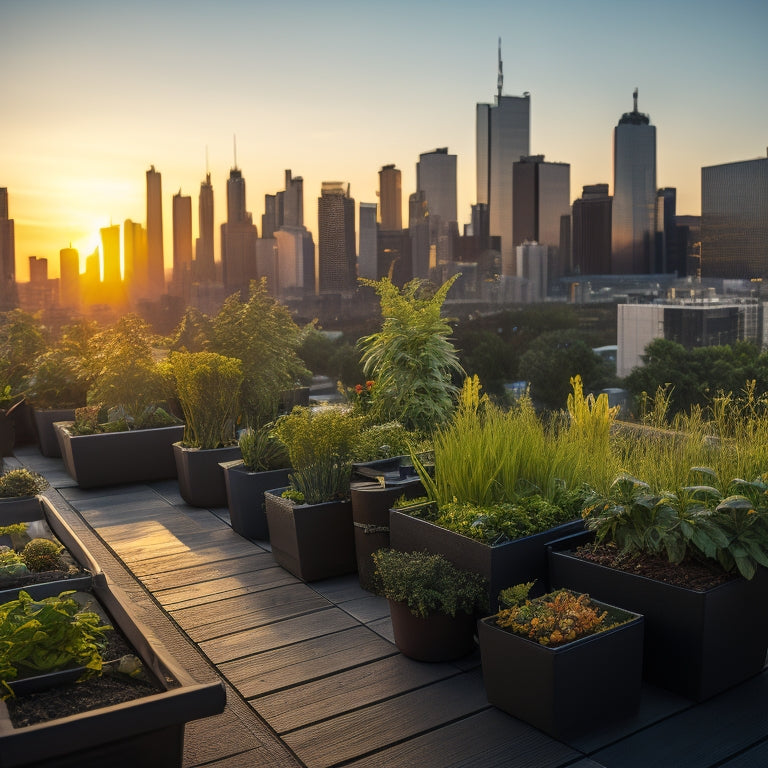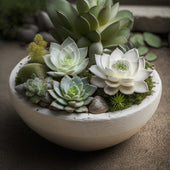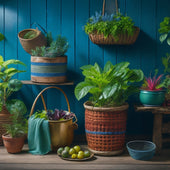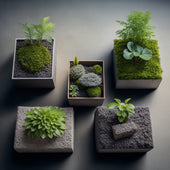
7 Essentials for Urban Rooftop Agriculture Success
Share
When cultivating a successful urban rooftop agriculture project, you'll need to focus on seven essential areas. First, assess the rooftop's structural integrity to guarantee it can support your project. Next, select climate-resilient crops that thrive in harsh conditions. Implement water conservation strategies like drip irrigation and rainwater harvesting to minimize waste. Design an efficient irrigation system that delivers water directly to roots. Manage urban microclimates by mitigating wind, temperature, and pest issues. Implement integrated pest control methods that prioritize organic solutions. Finally, guarantee rooftop accessibility safety by prioritizing clear pathways, non-slip materials, and regular inspections. From here, you can build a thriving rooftop garden that produces bountiful harvests.
Key Takeaways
• Assess rooftop structural integrity to ensure load-bearing capacity for soil, plants, and equipment, and address any issues before initiating the project.
• Select climate-resilient crops that adapt to rooftop microclimates, and incorporate efficient layout strategies to maximize space and yield.
• Implement efficient irrigation systems, such as drip irrigation, and utilize rainwater harvesting methods to minimize water waste and reliance on municipal supplies.
• Ensure rooftop accessibility and safety by prioritizing safety measures, providing clear pathways, and regularly inspecting and maintaining equipment and structures.
• Develop a comprehensive emergency preparedness plan, including evacuation procedures, regular drills, and accessible emergency supplies, to mitigate risks and ensure a safe working environment.
Assessing Rooftop Structural Integrity
Before you start planning your urban rooftop agriculture project, you must determine if your rooftop can handle the weight and stress of a garden, as the structural integrity of your building is essential to guaranteeing a safe and successful harvest.
To do this, you'll need to assess your rooftop's load-bearing capacity, which is the maximum weight it can support without compromising its structure. This includes the weight of the soil, plants, irrigation system, and any other equipment you plan to use.
You should also inspect your rooftop materials to verify they're suitable for a garden. For instance, a rooftop made of wood or asphalt shingles may not be ideal, as they can be prone to water damage or rot.
On the other hand, rooftops made of metal, concrete, or EPDM (rubber) are often more durable and suitable for rooftop agriculture.
Additionally, check for any signs of wear and tear, such as cracks, rust, or corrosion, and address them before proceeding with your project.
Selecting Climate-Resilient Crops
As you design your urban rooftop agriculture project, you'll need to choose crops that can thrive in the unique climate conditions of your rooftop, where wind, sun, and temperature fluctuations can be more extreme than those on the ground. This requires careful consideration of crop selection criteria, including tolerance to wind, drought, and extreme temperatures.
You'll want to select crops that are resistant to pests and diseases, and can adapt to the rooftop's microclimate.
When selecting crops, consider their growth habits, maturation rates, and space requirements. For example, vining crops like tomatoes and cucumbers can be trained to grow up trellises, maximizing space. Leafy greens like kale and spinach are ideal for rooftop gardens, as they're easy to grow and can thrive in partial shade.
Seasonal planting strategies are also essential. Plant cool-season crops like broccoli and carrots in the spring or fall, when temperatures are cooler. Warm-season crops like peppers and eggplants do better in the summer.
Water Conservation Strategies
As you start designing your urban rooftop agriculture project, you'll need to prioritize water conservation to guarantee sustainability.
You'll want to implement efficient irrigation systems that minimize waste and optimize water distribution.
Efficient Irrigation Systems
Set up an efficient irrigation system to maximize water conservation, as it's crucial to deliver the right amount of water directly to the roots of your rooftop crops, reducing evaporation and runoff.
You'll want to take into account implementing drip irrigation, which provides a slow and steady release of water, directly to the roots, minimizing waste. This approach is particularly effective for rooftop gardens, where water may be limited.
If you're using hydroponic systems, you'll need to verify your irrigation system is tailored to meet the specific needs of your crops. Hydroponic systems require precise control over water delivery, and an efficient irrigation system will help you achieve ideal results.
Make sure to monitor soil moisture levels and adjust your irrigation schedule accordingly. You should also think about automating your irrigation system to guarantee consistent water delivery, even when you're not on-site.
Rainwater Harvesting Methods
You can greatly reduce your rooftop garden's reliance on municipal water supplies by implementing rainwater harvesting methods, an essential strategy for water conservation. By collecting and storing rainwater, you can supplement your irrigation needs and minimize your environmental footprint.
To get started, consider the following rainwater harvesting methods:
-
Roof Catchment Systems: Design your rooftop garden's drainage systems to channel rainwater into storage tanks. This is a simple and effective way to collect rainwater, especially if you have a large rooftop area.
-
Gutter Systems: Install gutters around your rooftop garden to collect rainwater and direct it into storage tanks. Make sure to include a first flush device to remove debris and contaminants.
-
Ground-Level Collection: If you don't have a rooftop garden, you can still collect rainwater at ground level. Use a tarp or a rainwater collection pad to channel rainwater into storage tanks.
Designing Efficient Irrigation Systems
Designing an efficient irrigation system for your rooftop garden requires careful consideration of water delivery methods, soil type, and crop selection to minimize waste and optimize yields. You'll want to choose a system that delivers water directly to the roots of your plants, reducing evaporation and runoff. Drip irrigation is a popular choice for rooftop gardens, as it provides a slow and steady supply of water to the roots. Hydroponic systems are another option, where plants are grown in a nutrient-rich solution rather than soil.
| Irrigation Method | Advantages | Challenges |
|---|---|---|
| Drip Irrigation | Reduces water waste, increases crop yields | Requires frequent monitoring, can be labor-intensive |
| Hydroponic Systems | Allows for precise nutrient control, increases crop yields | Requires significant upfront investment, can be complex to set up |
| Sprinkler Systems | Easy to set up, covers large areas | Wastes water through evaporation, can lead to overwatering |
| Soaker Hoses | Easy to set up, reduces evaporation | Can be prone to clogging, may not reach all areas of the garden |
Managing Urban Microclimates
As you refine your rooftop garden's irrigation system, it's equally important to contemplate the unique microclimate that surrounds your urban oasis. Factors like wind direction, shading, and temperature fluctuations can greatly impact plant growth and health. You must consider the microclimate variation that exists on your rooftop, which can be markedly different from the surrounding urban environment.
To effectively manage your urban microclimate, keep the following strategies in mind:
-
Assess wind patterns: Identify areas prone to strong winds and take measures to mitigate their impact, such as using windbreaks or selecting wind-tolerant plant species.
-
Enhance temperature regulation: Use techniques like shading, mulching, or whitewashing to regulate soil temperature and reduce heat stress on plants.
-
Monitor and adapt to local conditions: Regularly observe and respond to changes in your microclimate, adjusting your garden's layout, plant selection, and maintenance strategies as needed to guarantee ideal plant growth and health.
Implementing Integrated Pest Control
Effective rooftop gardeners must develop a thorough pest management strategy that incorporates physical, cultural, biological, and chemical controls to minimize damage and guarantee a thriving urban oasis.
You'll need to stay vigilant, monitoring your plants regularly for signs of pests or diseases. To do this, you'll need to develop effective pest identification techniques, such as inspecting plants from top to bottom, using magnifying glasses, and monitoring for signs of damage or unusual growth.
Once you've identified the pest, you can choose the most effective control method. Organic pest solutions are often preferred, as they're safer for the environment and human consumption.
Biological controls, like introducing beneficial insects, can also be highly effective. Don't forget to incorporate physical controls, like row covers or traps, and cultural controls, like adjusting irrigation and pruning, into your strategy.
Ensuring Rooftop Accessibility Safety
When cultivating a thriving rooftop garden, you must prioritize accessibility safety to prevent accidents and guarantee a smooth workflow.
Rooftop agriculture comes with unique challenges, such as traversing uneven terrain, managing heavy loads, and dealing with inclement weather conditions. To secure a safe working environment, implement the following rooftop safety measures:
-
Install handrails and guardrails to prevent falls and provide support when traversing stairs or steep slopes.
-
Ensure proper lighting, especially in areas with low visibility or heavy foot traffic, to prevent tripping hazards and improve overall visibility.
-
Develop and regularly practice emergency evacuation plans with your team, including procedures for fires, medical emergencies, and severe weather events.
Frequently Asked Questions
Can Rooftop Agriculture Be Profitable for Small-Scale Urban Farmers?
Like a green thumb Midas, you can turn your rooftop into a goldmine if you tap into market demand and choose the right crop selection, ensuring a profitable venture that's the envy of all small-scale urban farmers.
How Do I Handle Liability Concerns for Rooftop Farm Visitors?
You'll need to prioritize visitor safety by implementing measures like secure walkways and handrails, and having visitors sign liability waivers before touring your rooftop farm to minimize risk and protect yourself from potential lawsuits.
Are There Grants or Incentives for Urban Rooftop Agriculture Projects?
You'll be interested to know that 40% of urban farms receive grant funding. When applying for grants, you'll need to research funding sources, craft a strong grant application, and highlight your project's community benefits and environmental impact.
Can I Use Rooftop Agriculture to Offset Building Energy Costs?
You can leverage rooftop agriculture to offset building energy costs by utilizing the added rooftop insulation, which reduces heat loss and energy consumption, resulting in significant energy savings for your building.
Do I Need Special Insurance for Urban Rooftop Agricultural Operations?
You're wise to wonder if you need special insurance for your urban rooftop agricultural operation. Investigating this theory, you'll find that yes, you do; liability, crop, and equipment insurance are must-haves for effective risk management.
Related Posts
-

What Makes a Great Planter for Succulents
When selecting a great planter for succulents, you'll want to take into account a combination of factors to guarantee...
-

What Makes a Great Planter for Succulents
When selecting a great planter for succulents, you'll want to take into account a combination of factors to guarantee...
-

What Makes a Great Planter for Succulents
When selecting a great planter for succulents, you'll want to take into account a combination of factors to guarantee...
-

What Makes a Great Planter for Succulents
When selecting a great planter for succulents, you'll want to take into account a combination of factors to guarantee...
-

What Makes a Great Planter for Succulents
When selecting a great planter for succulents, you'll want to take into account a combination of factors to guarantee...
-

What Makes a Great Planter for Succulents
When selecting a great planter for succulents, you'll want to take into account a combination of factors to guarantee...
-

What Makes a Great Planter for Succulents
When selecting a great planter for succulents, you'll want to take into account a combination of factors to guarantee...
-

What Makes a Great Planter for Succulents
When selecting a great planter for succulents, you'll want to take into account a combination of factors to guarantee...
-

What Makes a Great Planter for Succulents
When selecting a great planter for succulents, you'll want to take into account a combination of factors to guarantee...
-

What Makes a Great Planter for Succulents
When selecting a great planter for succulents, you'll want to take into account a combination of factors to guarantee...
-

What Makes a Great Planter for Succulents
When selecting a great planter for succulents, you'll want to take into account a combination of factors to guarantee...
-

What Makes a Great Planter for Succulents
When selecting a great planter for succulents, you'll want to take into account a combination of factors to guarantee...
-

What Makes a Great Planter for Succulents
When selecting a great planter for succulents, you'll want to take into account a combination of factors to guarantee...
-

What Makes a Great Planter for Succulents
When selecting a great planter for succulents, you'll want to take into account a combination of factors to guarantee...
-

What Makes a Great Planter for Succulents
When selecting a great planter for succulents, you'll want to take into account a combination of factors to guarantee...
-

What Makes a Great Planter for Succulents
When selecting a great planter for succulents, you'll want to take into account a combination of factors to guarantee...
-

What Makes a Great Planter for Succulents
When selecting a great planter for succulents, you'll want to take into account a combination of factors to guarantee...
-

What Makes a Great Planter for Succulents
When selecting a great planter for succulents, you'll want to take into account a combination of factors to guarantee...
-

What Makes a Great Planter for Succulents
When selecting a great planter for succulents, you'll want to take into account a combination of factors to guarantee...
-

What Makes a Great Planter for Succulents
When selecting a great planter for succulents, you'll want to take into account a combination of factors to guarantee...
-

What Makes a Great Planter for Succulents
When selecting a great planter for succulents, you'll want to take into account a combination of factors to guarantee...
-

What Makes a Great Planter for Succulents
When selecting a great planter for succulents, you'll want to take into account a combination of factors to guarantee...
-

What Makes a Great Planter for Succulents
When selecting a great planter for succulents, you'll want to take into account a combination of factors to guarantee...
-

What Makes a Great Planter for Succulents
When selecting a great planter for succulents, you'll want to take into account a combination of factors to guarantee...
-

7 Creative Upcycled Planter Tutorials to Try Now
Get ready to transform your outdoor space with these 7 creative upcycled planter tutorials! Start by turning cinder b...
-

7 Creative Upcycled Planter Tutorials to Try Now
Get ready to transform your outdoor space with these 7 creative upcycled planter tutorials! Start by turning cinder b...
-

7 Creative Upcycled Planter Tutorials to Try Now
Get ready to transform your outdoor space with these 7 creative upcycled planter tutorials! Start by turning cinder b...
-

7 Creative Upcycled Planter Tutorials to Try Now
Get ready to transform your outdoor space with these 7 creative upcycled planter tutorials! Start by turning cinder b...
-

7 Creative Upcycled Planter Tutorials to Try Now
Get ready to transform your outdoor space with these 7 creative upcycled planter tutorials! Start by turning cinder b...
-

7 Creative Upcycled Planter Tutorials to Try Now
Get ready to transform your outdoor space with these 7 creative upcycled planter tutorials! Start by turning cinder b...
-

7 Creative Upcycled Planter Tutorials to Try Now
Get ready to transform your outdoor space with these 7 creative upcycled planter tutorials! Start by turning cinder b...
-

7 Creative Upcycled Planter Tutorials to Try Now
Get ready to transform your outdoor space with these 7 creative upcycled planter tutorials! Start by turning cinder b...
-

7 Creative Upcycled Planter Tutorials to Try Now
Get ready to transform your outdoor space with these 7 creative upcycled planter tutorials! Start by turning cinder b...
-

7 Creative Upcycled Planter Tutorials to Try Now
Get ready to transform your outdoor space with these 7 creative upcycled planter tutorials! Start by turning cinder b...
-

7 Creative Upcycled Planter Tutorials to Try Now
Get ready to transform your outdoor space with these 7 creative upcycled planter tutorials! Start by turning cinder b...
-

7 Creative Upcycled Planter Tutorials to Try Now
Get ready to transform your outdoor space with these 7 creative upcycled planter tutorials! Start by turning cinder b...
-

7 Creative Upcycled Planter Tutorials to Try Now
Get ready to transform your outdoor space with these 7 creative upcycled planter tutorials! Start by turning cinder b...
-

7 Creative Upcycled Planter Tutorials to Try Now
Get ready to transform your outdoor space with these 7 creative upcycled planter tutorials! Start by turning cinder b...
-

7 Creative Upcycled Planter Tutorials to Try Now
Get ready to transform your outdoor space with these 7 creative upcycled planter tutorials! Start by turning cinder b...
-

7 Creative Upcycled Planter Tutorials to Try Now
Get ready to transform your outdoor space with these 7 creative upcycled planter tutorials! Start by turning cinder b...
-

7 Creative Upcycled Planter Tutorials to Try Now
Get ready to transform your outdoor space with these 7 creative upcycled planter tutorials! Start by turning cinder b...
-

7 Creative Upcycled Planter Tutorials to Try Now
Get ready to transform your outdoor space with these 7 creative upcycled planter tutorials! Start by turning cinder b...
-

7 Creative Upcycled Planter Tutorials to Try Now
Get ready to transform your outdoor space with these 7 creative upcycled planter tutorials! Start by turning cinder b...
-

7 Creative Upcycled Planter Tutorials to Try Now
Get ready to transform your outdoor space with these 7 creative upcycled planter tutorials! Start by turning cinder b...
-

7 Creative Upcycled Planter Tutorials to Try Now
Get ready to transform your outdoor space with these 7 creative upcycled planter tutorials! Start by turning cinder b...
-

7 Creative Upcycled Planter Tutorials to Try Now
Get ready to transform your outdoor space with these 7 creative upcycled planter tutorials! Start by turning cinder b...
-

7 Creative Upcycled Planter Tutorials to Try Now
Get ready to transform your outdoor space with these 7 creative upcycled planter tutorials! Start by turning cinder b...
-

7 Creative Upcycled Planter Tutorials to Try Now
Get ready to transform your outdoor space with these 7 creative upcycled planter tutorials! Start by turning cinder b...
-

Why Choose the Right Blocks for Your Planters
When creating a thriving planter, you need to choose the right blocks to support the entire ecosystem. Start by evalu...
-

Why Choose the Right Blocks for Your Planters
When creating a thriving planter, you need to choose the right blocks to support the entire ecosystem. Start by evalu...
-

Why Choose the Right Blocks for Your Planters
When creating a thriving planter, you need to choose the right blocks to support the entire ecosystem. Start by evalu...
-

Why Choose the Right Blocks for Your Planters
When creating a thriving planter, you need to choose the right blocks to support the entire ecosystem. Start by evalu...
-

Why Choose the Right Blocks for Your Planters
When creating a thriving planter, you need to choose the right blocks to support the entire ecosystem. Start by evalu...
-

Why Choose the Right Blocks for Your Planters
When creating a thriving planter, you need to choose the right blocks to support the entire ecosystem. Start by evalu...
-

Why Choose the Right Blocks for Your Planters
When creating a thriving planter, you need to choose the right blocks to support the entire ecosystem. Start by evalu...
-

Why Choose the Right Blocks for Your Planters
When creating a thriving planter, you need to choose the right blocks to support the entire ecosystem. Start by evalu...
-

Why Choose the Right Blocks for Your Planters
When creating a thriving planter, you need to choose the right blocks to support the entire ecosystem. Start by evalu...
-

Why Choose the Right Blocks for Your Planters
When creating a thriving planter, you need to choose the right blocks to support the entire ecosystem. Start by evalu...
-

Why Choose the Right Blocks for Your Planters
When creating a thriving planter, you need to choose the right blocks to support the entire ecosystem. Start by evalu...
-

Why Choose the Right Blocks for Your Planters
When creating a thriving planter, you need to choose the right blocks to support the entire ecosystem. Start by evalu...
-

Why Choose the Right Blocks for Your Planters
When creating a thriving planter, you need to choose the right blocks to support the entire ecosystem. Start by evalu...
-

Why Choose the Right Blocks for Your Planters
When creating a thriving planter, you need to choose the right blocks to support the entire ecosystem. Start by evalu...
-

Why Choose the Right Blocks for Your Planters
When creating a thriving planter, you need to choose the right blocks to support the entire ecosystem. Start by evalu...
-

Why Choose the Right Blocks for Your Planters
When creating a thriving planter, you need to choose the right blocks to support the entire ecosystem. Start by evalu...
-

Why Choose the Right Blocks for Your Planters
When creating a thriving planter, you need to choose the right blocks to support the entire ecosystem. Start by evalu...
-

Why Choose the Right Blocks for Your Planters
When creating a thriving planter, you need to choose the right blocks to support the entire ecosystem. Start by evalu...
-

Why Choose the Right Blocks for Your Planters
When creating a thriving planter, you need to choose the right blocks to support the entire ecosystem. Start by evalu...
-

Why Choose the Right Blocks for Your Planters
When creating a thriving planter, you need to choose the right blocks to support the entire ecosystem. Start by evalu...
-

Why Choose the Right Blocks for Your Planters
When creating a thriving planter, you need to choose the right blocks to support the entire ecosystem. Start by evalu...
-

Why Choose the Right Blocks for Your Planters
When creating a thriving planter, you need to choose the right blocks to support the entire ecosystem. Start by evalu...
-

Why Choose the Right Blocks for Your Planters
When creating a thriving planter, you need to choose the right blocks to support the entire ecosystem. Start by evalu...


